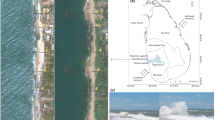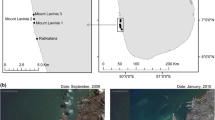Abstract
Beach erosion is an increasing threat to the natural resources of many countries, and is expected to increase with rising sea-level. West Tasmania has extensive fetch from the circum-polar Antarctic Ocean, also located in the “Roaring Forties” latitudes. Beaches of this coastline previously studied have shown major erosion, attributed to recent relative sea-level rise as they are largely secluded from human impacts. This study assessed Four Mile Beach, located in the central section of the west coast using methods of spatial analysis 1952–2011, beach profile survey and sediment analysis. Results showed only minor erosion of the vegetation line to the north, and stability and progradation in the central and southern extents of the beach. Blowouts showed more major changes, with three large blowouts towards the south becoming parabolic dunes, and one in the north re-vegetating. Dune sediment was mostly rounded fine sand indicative of active aeolian processes, while seaward edge sediment was sub-angular with a 15–20% of carbonate content on most transects, indicative of a sediment supply from offshore. Ongoing coastal stability of this pristine coastline would be facilitated by continued monitoring, management of any potential human impacts, and control of any potential invasive species that may affect sediment budgets.




Similar content being viewed by others
References
Bini M, Isola I, Pappalardo RA, Favalli M, Ragaini L, Zanchetta G (2014) Abrasive notches along the Atlantic Patagonian coast and their potential use as sea level markers: the case of Puerto Deseado (Santa Cruz, Argentina). Earth Surf Process Landf 39(11):1550–1558
Bird E (2008) Coastal geomorphology, 2nd edn. Wiley, West Sussex
Boak EH, Turner IL (2005) Shoreline definition and detection: a review. J Coast Res 21(4):688–703
Bombana B, Ariza E (2018) Clarifying some assumptions of coastal management: analysis of values and uncertainties embedded in beach quality indexes. Ecol Indic 91:376–385
Bottrill RS, Woolley RN (2015) Sand testing: SW Tasmania. In: Eberhard R, Sharples C, Bowden N, Comfort M (eds) Monitoring the erosion status of oceanic beaches in the Tasmania wilderness world heritage area: establishment report. Nature conservation report series 15/3. Natural & Cultural Heritage Division, Department of Primary Industries, Parks, Water & Environment, Hobart, pp 84–205
Boye CB, Appeaning Addo K, Wiafe G, Dzigbodi-Adjimah K (2018) Spatio-temporal analyses of shoreline change in the Western region of Ghana. J Coast Conserv 22(4):769–776
Brownett JM, Mills RS (2017) The development and application of remote sensing to monitor sand dune habitats. J Coast Conserv 21(5):643–656
Brunsden D, Thornes JB (1979) Landscape sensitivity and change. Trans Inst Br Geogr 4:463–484
Castelle B, Turner IL, Ruessink BG, Tomlinson RB (2007) Impact of storms on beach erosion: Broadbeach (Gold Coast, Australia). J Coast Res SI 50:534–539
Catchpole H (2007) Roaring forties. ABC Science, Sydney
Church JA, Clark PU, Cazenave A, Gregory JM, Jevrejeva S, Levermann A, Merrifield MA, Milne GA, Nerem RS, Nunn PD, Payne AJ, Pfeffer WT, Stammer D, Unnikrishnan AS (2013) Sea level change. In: Stocker TF, Qin D, Plattner G, Tignor M, Allen SK, Boschung J, Nauels A, Xia Y, Bex V, Midgeley PM (eds) Climate change 2013: The physical science basis. Contribution of Working Group I to the Fifth Assessment Report of the Intergovernmental Panel on Climate Change. Cambridge University Press, Cambridge and New York, pp 1137–1216
Davies J, Hudson J (1987a) Sources of shore sediment on the north coast of Tasmania. Pap Proc Royal Soc Tas 121:137–151
Davies J, Hudson J (1987b) Differential supply and longshore transport as determinants of sediment distribution on the north coast of Tasmania. Mar Geol 77(3–4):233–245
Department of Premier and Cabinet (2016) Mitigating natural hazards through land use planning and building control: coastal hazards technical report. Tasmanian Government, Hobart
Donadio C, Vigliotti M, Valente R, Stanislao C, Ivaldi R, Ruberti D (2018) Anthropic vs. natural shoreline changes along the northern Campania coast, Italy. J Coast Conserv 22(5):939–955
DPIPWE (2019) Coordinate, height and tide datums – Tasmania. Land Tasmania, Hobart Retreived from https://dpipwe.tas.gov.au/land-tasmania/geospatialinfrastructure-surveying/geodetic-survey/coordinate-height-and-tide-datums-tasmania. Accessed 2 Feb 2019
Duvat VK (2019) A global assessment of atoll island planform changes over the past decades. WIRES. Clim Chang 10(1). https://doi.org/10.1002/wcc.557
Eberhard R, Sharples C, Bowden N, Comfort M (2015) Monitoring the erosion status of oceanic beaches in the Tasmania wilderness world heritage area: establishment report. Nature conservation report series 15/3. Natural & Cultural Heritage Division, Department of Primary Industries, Parks, Water & Environment, Hobart
Ellison JC, Mosley A, Helman M (2017) Assessing atoll shoreline condition to guide community management. Ecol Indic 75:321–330
Fairchild I, Hendry G, Quest M, Tucker M (1988) Chemical analysis of sedimentary rocks. In: Tucker M (ed) Techniques in sedimentology. Blackwell Scientific Publications, Oxford, pp 274–354
Folk RL (1954) The distinction between grain size and mineral composition in sedimentary-rock nomenclature. J Geol 62:344–359
Folk RL (1966) A review of grain size parameters. Sedimentol 6(2):73–93
Folk RL, Ward WC (1957) Brazos River Bar: a study in the significance of grain size parameters. J Sediment Petrol 27:3–27
Gehrels WR, Callard SL, Moss PT, Marshall WA, Blaauw M, Hunter J, Milton JA, Garnett MH (2012) Nineteenth and twentieth century sea-level changes in Tasmania and New Zealand. Earth Planet Sci Lett 315–316:94–102
Hesp P (2002) Foredunes and blowouts: initiation, geomorphology and dynamics. Geomorphol 48(1–3):245–268
Hinkel J, Nicholls RJ, Tol RSJ, Wang ZB, Hamilton JM, Boot G, Vafeidis T, Mcfadden L, Ganopolski A, Klein RJT (2013) A global analysis of erosion of sandy beaches and sea-level rise: an application of DIVA. Glob Planet Chang 111:150–158
Hunter J, Coleman R, Pugh D (2003) The sea level at Port Arthur, Tasmania, from 1841 to the present. Geophys Res Lett 30(7):1401. https://doi.org/10.1029/2002GL016813
Jiang C, Wu Z, Chen J, Deng B, Long Y (2015) Sorting and sedimentology character of sandy beach under wave action. Procedia Eng 116:771–777
Johnston E, Ellison JC (2014) Evaluation of beach rehabilitation success, Turners Beach, Tasmania. J Coast Conserv 18:617–629
Mason D, Gurney C, Kennett M (2000) Beach topography mapping - a comparison of techniques. J Coast Conserv 6(1):113–124
Masselink G, Pattiaratchi B (2001) Seasonal changes in beach morphology along the sheltered coastline of Perth, Western Australia. Mar Geol 172(3–4):243–263
Masselink G, Turner I (1999) The effects of tides on beach morphodynamics. In: Short AD (ed) Handbook of beach and shoreface dynamics. J Wiley and Sons, New York, pp 204–229
Masterman R, Ellison JC (2018) Influence of introduced Ammophila arenaria on coastal progradation: assessment by spatial analysis. J Aquac Mar Biol 7(5):268–273. https://doi.org/10.15406/jamb.2018.07.00219
Masterman R, Ellison JC (2020) Analysis of beach and foredune changes by aerial photography and topographic profiles, Tasmania, Australia. J Aquac Mar Biol 9(4):114–121. https://doi.org/10.15406/jamb.2020.09.00286
McManus J (1988) Grain size determination and interpretation. In: Tucker M (ed) Techniques in sedimentology. Blackwell Scientific Publications, Oxford, pp 63–85
Morton RA, Mark PL, Jeffrey GP, Michael AC (1993) Monitoring beach changes using GPS surveying techniques. J Coast Res 9:702–720
Niya AK, Alesheikh AA, Soltanpor M, Kheirkhahzarkesh MM (2013) Shoreline change mapping using remote sensing and GIS - case study: Bushehr Province. Int J Remote Sens Appl 3:102–107
NOAA (2019) What are the roaring forties? Retrieved from https://oceanservice.noaa.gov/facts/roaring-forties.html. Accessed 8 Feb 2019
Parker A (2013) Minimum 60 years of recording are needed to compute the sea level rate of rise in the Western South Pacific. Nonlinear Eng 3(1):1–10
Pedreros R, Howa HL, Michel D (1996) Application of grain size trend analysis for the determination of sediment transport pathways in intertidal areas. Mar Geol 135(1–4):35–49
Poizot E, Anfuso G, Méar Y, Bellido C (2013) Confirmation of beach accretion by grain-size trend analysis: Camposoto beach, Cádiz, SW Spain. Geo-Mar Lett 33(4):263–272
Powers MC (1953) A new roundness scale for sedimentary particles. J Sediment Res 23:117–119
Ranasinghe R, Callaghan D, Stive MJF (2012) Estimating coastal recession due to sea level rise: beyond the Bruun rule. Clim Change 110(3–4):561–574
Rosskopf CM, Di Paola G, Atkinson DE, Rodríguez G, Walker IJ (2018) Recent shoreline evolution and beach erosion along the central Adriatic coast of Italy: the case of Molise region. J Coast Conserv 22(5):879–895
Rozé F, Lemauviel S (2004) Sand dune restoration in North Brittany, France: a 10-year monitoring study. Restor Ecol 12:29–35
Sharples C (2006) Indicative mapping of Tasmanian coastal vulnerability to climate change and sea-level rise: explanatory report. Consultant report to the Department of Primary Industries and Water, Tasmania, Hobart
Sharples C (2007) Shoreline change at Roches Beach 1957–2006, south-eastern Tasmania, A Report to the Antarctic Climate and Ecosystems Co-operative Research Centre, Hobart, Tasmania
Sharples C, Walford H, Watson C, Ellison JC, Hua Q, Bowden N, Bowman D (2020) Ocean Beach, Tasmania: A swell-dominated shoreline reaches climate-induced recessional tipping point? Mar Geol 419:106081
Shepard FP, Young R (1961) Distinguishing between beach and dune sands. J Sediment Res 31(2):196–214
Short AD (1999a) Global variation in beach systems. In: Short AD (ed) Handbook of beach and shoreface dynamics. Wiley, New York, pp 21–35
Short AD (1999b) Wave-dominated beaches. In: Short AD (ed) Handbook of beach and shoreface dynamics. Wiley, New York, pp 173–203
Short A (2006a) Australian beach systems—nature and distribution. J Coast Res 221(1):11–27
Short A (2006b) Beaches of the Tasmanian coast and islands. Sydney University Press, Sydney
Slott JM, Murray AB, Ashton AD, Crowley TJ (2006) Coastline responses to changing storm patterns. Geophys Res Lett 33. https://doi.org/10.1029/2006GL027445
Smart J (1977) Late quaternary sea-level changes, Gulf of Carpentaria, Australia. Geology 5(12):755–759
Smith MJ, Cromley RG (2012) Measuring historical coastal change using GIS and the change polygon approach. Trans GIS 16:3–15
Sonu CJ, Van Beek JL (1971) Systematic beach changes on the outer banks, North Carolina. J Geol 79(4):416–425
Splinter KD, Kearney ET, Turne IL (2018) Drivers of alongshore variable dune erosion during a storm event: observations and modelling. Coast Eng 131:31–41
Stewart HB (1958) Sedimentary reflections of depositional environment in San Miguel lagoon, Baja California, Mexico. Am Assoc Pet Geol Bull 42(11):2567–2618
Tasmanian Government (2019) List map: Hillshade colour base layer. Tasmanian Government, Hobart. Retrieved from https://maps.thelist.tas.gov.au/listmap/app/list/map. Accessed 20 Mar 2019
TASMARC (The Tasmanian Shoreline Monitoring and Archiving Project) (2019) TASMARC database. Retrieved from http://www.tasmarc.info/. Accessed 13 Mar 2019
Thom BG, Hall W (1991) Behaviour of beach profiles during accretion and erosion dominated periods. Earth Surf Process Landf 16:113–127
Walford H (2011) Assessment of coastal erosion at Ocean Beach, Western Tasmania. Dissertation, University of Tasmania
Watson CS, White NJ, Church JA, King MA, Burgette RJ, Legresy B (2015) Unabated global mean sea-level rise over the satellite altimeter era. Nature Clim Ch 5(6):565–568
Wentworth CK (1922) A scale of grade and class terms for clastic sediments. J Geol 30:377–392
White NJ, Haigh ID, Church JA, Koen T, Watson CS, Pritchard TR, Watson PJ, Burgette RJ, Mcinnes KL, You Z-J, Zhang X, Tregoning P (2014) Australian sea levels—trends, regional variability and influencing factors. Earth-Sci Rev 136:155–174
Williams AT, Rangel-Buitrago N, Pranzini E, Anfuso G (2018) The management of coastal erosion. Ocean Coast Manag 156:4–20
Wong PP, Losada IJ, Gattuso J-P, Hinkel J, Khattabi A, McInnes KL, Saito Y, Sallenger A (2014) Coastal systems and low-lying areas. In: Barros VR, Field CB, Dokken DJ, Mastrandrea MD, Mach KJ, Bilir TE, Chatterjee M, Ebi KL, Estrada YO, Genova RC, Girma B, Kissel ES, Levy AN, MacCracken S, Mastrandrea PR, White LL (eds) Climate change 2014: impacts, adaptation, and vulnerability. Part B: regional aspects. Cambridge University Press, Cambridge and New York, pp 361–309
Author information
Authors and Affiliations
Corresponding author
Additional information
Publisher’s note
Springer Nature remains neutral with regard to jurisdictional claims in published maps and institutional affiliations.
Rights and permissions
About this article
Cite this article
Gilmour, R., Ellison, J.C. Assessment of stability of an exposed microtidal beach, Western Tasmania. J Coast Conserv 25, 21 (2021). https://doi.org/10.1007/s11852-021-00805-8
Received:
Revised:
Accepted:
Published:
DOI: https://doi.org/10.1007/s11852-021-00805-8




